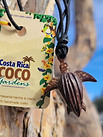
Adopt a Hatchling
Change the odds for sea turtles
With less than a 1% chance of survival, leatherback hatchlings need your help! Your symbolic adoption protects hatchlings and their nests from immediate threats such as predators, tidal inundation, and illegal harvest. Donating in honor of a loved one? Be sure to include your honoree's name, email address, and a special message on our donation form. Adoptions made as a gift will be emailed to the purchaser. See the full adoption packet contents below.

PROTECT 1 MILE OF BEACH
Beach debris like fishing nets ensnare hatchlings on their journey to the ocean.
You'll receive:
Signed certificate and Turtle Advocate's atlas
.jpg)
ADOPT A PAIR
Two is always better than one! Hatchlings use the natural light of the ocean to navigate.
You'll receive: Certificate, atlas, desktop photos, and choice of tote bag or coco wood jewelry

ADOPT A
HATCHLING
.jpg)
Turtles face a 1% survival rate, so every hatchling important to this species' survival.
You'll receive:
A certificate, atlas, and desktop photos
ADOPT A NEST
The collective digging of the hatchings helps all the hatchlings make it to the surface safely.
You'll receive: Certificate, atlas, desktop photos, tote bag, and coco wood jewelry

ADOPT FOR A CLASSROOM
Adopt a hatchling for your classroom, or gift an adoption
to a deserving teacher!
You'll receive: classroom kit, atlas, and certificate



Check your giving level to see which of the goodies below are included in your adoption!

Adoption certificate
.jpg)

Costa Rican jewelry, made from coco wood by local artisans



Turtle Advocate's Atlas



10 page classroom kit
Protecting
Sea Turtles
The endangered leatherback (Dermochelys coriacea) is the largest of all sea turtles. Researchers, volunteers, and students at Costa Rica's Pacuare Reserve conduct night-time censuses of nesting turtles throughout the nesting season. They collect key biometric data like length and width and check for tags and other identifying marks.
If nests are found in unsuitable locales, they're relocated to the Reserve's hatchery to ensure the safety and success of the hatchlings.

Pacuare Reserve's
Hatcheries
Home to the most important leatherback nesting beach in Costa Rica, Pacuare Reserve is a scientifically managed wildlife reserve on Costa Rica's Caribbean Coast.
Although Pacuare Reserve’s initial efforts successfully safeguarded nests, eggs, and mothers, and the beach continues to be visited by nesting females each year, reports show that recent hatching rates of in situ—literally “in place”—nests have been poor.
Only 23% of eggs from natural nests are actually hatching. In response, Pacuare Reserve has developed a method to prepare sand, relocate, and safely sequester threatened sea turtle nests—the hatcheries of Pacuare Reserve.

